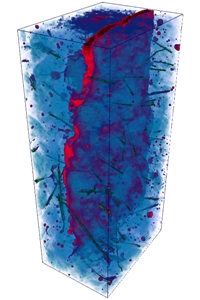Nov 5 2013
Steel fiber reinforced concrete (SFRC) is a practical construction material that is quick and easy to use. But monitoring SFRC quality is difficult, and this has kept industry acceptance low. A new method offers a quick way to examine its composition.
 The CT scan creates a detailed image of the concrete cylinder. The crack runs through the darker surface. © Fraunhofer ITWM
The CT scan creates a detailed image of the concrete cylinder. The crack runs through the darker surface. © Fraunhofer ITWM
Concrete is the world’s most popular building material: we use it to bridge rivers and valleys, build walls and line tun- nels. The most common form of concrete is steel reinforced – a principle that will be familiar to anyone who has ever taken a closer look at a building site. Long steel rods, also called rebars, are bent into a dense framework, known as the reinforcement, which is then filled with concrete. But building with steel reinforced concrete is time consuming. It can take days or even weeks before the reinforcement for large buildings is fully assembled, the rebars bound together, and everything ready for the concrete pour.
Steel fiber reinforced concrete is a much quicker alternative, as steel fibers about the length of pine needles are simply mixed in to the liquid concrete. Once the concrete sets, this network of fibers does exactly the same job as traditional rebar reinforcement, increasing the concrete’s tensile strength and counteracting cracks. Despite this, SFRC is not very widely used in the construction industry. The reason is that it was always very difficult to determine the quality of the material in the past, as there was no method for simply and reliably analyzing the distribution of fibers in the concrete. And yet it is this distribution that determines the material’s load bearing capacity. If there are zones within the concrete where fibers are clumped together, or if certain sections of a slab contain no steel fibers whatsoever, the material is much less able to withstand stresses. This represents an element of risk that many construction companies are not willing to take, causing them to shy away from using SFRC.
Software for evaluating the fiber matrix
Help has now arrived in the form of a new analysis method developed by mathematicians at the Fraunhofer Institute for Industrial Mathematics ITWM in Kaiserslautern. It uses probability calculations to work out the distribution of all the fibers within concrete samples in a matter of seconds. Project leader Dr. Ronald Rösch and his team of experts use X-ray computed tomography in a way he describes as not dissimilar to how CT scans are used in medicine. “The only difference is that we use it to examine samples taken from finished concrete components, not people,” Dr. Rösch explains. Scientists take a core sample about ten centimeters in length from the concrete to be tested. The sample is then X-rayed using an industrial CT scanner at a resolution around a thousand times finer than that achieved by medical scanners. This system reveals even the finest micrometer-sized structures within the material, and generates a high-resolution 3D data set for the concrete sample that contains some eight billion pixels – a huge file. Rösch and his team then use their new software to analyze this image data. By assessing differences in contrast, the software is able to assign each pixel to a particular structure within the material, be it concrete, a small stone, a trapped air bubble or a steel fiber. As the software works its way through the data set, all the fibers gradually become visible in the image.
„In and of itself this picture isn’t much use, however, as the tangled network of fibers is so dense that it’s almost impossible to make out individual ones with the naked eye,” explains Rösch. This led the experts in Kaiserslautern to develop software that brings order to the chaos by analyzing the system as a whole rather than evaluating each individual fiber. The program simply decides whether a particular pixel represents part of a steel fiber, and calculates the orientation of that fiber.
For each pixel, the program calculates the composition of the material adjacent to it. Is it a fiber, or not? Instances where numerous fibers touch or cross over each other are the most interesting, as to begin with it is unclear which of all the adjacent pixels actually belongs to which fiber. Does that pixel belong to the fiber coming in from the top left, or to the one cros- sing the others directly from above? This is where the probability calculation comes in. It weighs up the location of each pixel, and attributes it to a particular fiber based on what makes logical sense. The results tell the experts everything they need to know, revealing not only the proportion of steel fibers in the sample, but also their orientation. “This is especially important when the concrete component has to absorb forces coming from a particular direction,” says Rösch. An example of this is bridges carrying cars and trains at high speed.
It goes without saying that Rösch is aware of the system’s current limitations; a CT scanner the size of a small wall closet is simply too big for practical use on a building site. „But this is an obstacle we can overcome,” he says. “Our colleagues at the Fraunhofer Development Center for X-ray Technology EZRT in Erlangen have already developed a machine the size of a beer crate.” A prototype for practical application could be available in five years, Rösch estimates.